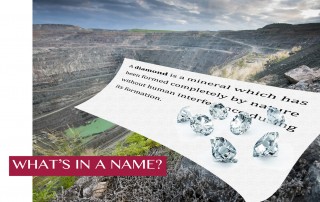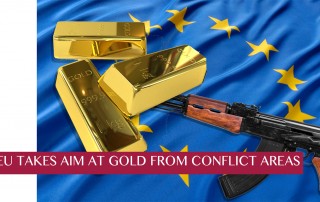About Steven Benson
This author has not yet filled in any details.So far Steven Benson has created 302 blog entries.
CIBJO releases Diamond Commission’s Special Report, focusing on language used to differentiate naturals from synthetics
SEPTEMBER 20, 2017
With fewer than seven weeks to go to the opening of the 2017 CIBJO Congress in Bangkok, Thailand, on November 5, 2017, the third of the CIBJO commissions’ Special Reports has been released. Prepared by Udi Sheintal, President of the organisation’s Diamond Commission, the report focuses on the terminology used both within the industry and in the consumer markets to differentiate between diamonds sourced naturally and those which are synthetic.
“Without proper analysis, diamonds formed in nature and synthetic diamonds created by man are difficult to distinguish from one another, and consequently the way they each are referred to – or named – is so important. That they are different products there is no argument. But how do we make certain that the consuming public understands this to be the case?” Mr. Sheintal asks at the opening of the report.
In terms of acceptable terminology in the trade, the situation is clear, the report emphasises. Both CIBJO’s Blue Book and the International Standards Organisation’s ISO 18232 rule state categorically that, if the word “diamond” is used without any modifying adjective, it can only be a natural stone. Synthetic diamonds have to be described using one of a number of acceptable modifiers, such as “synthetic,” “laboratory-created” or “laboratory-grown.” Any wilful deviation from these rules by a company selling synthetic diamonds is considered deliberately deceptive behaviour.
But, asks Mr. Sheintal, is the reluctance to use the word “natural” when communicating within the trade correct when it comes to the consumer market? “The diamond industry needs to take ownership of the adjective “natural,” and associate it with other modifiers like ‘real,’ ‘genuine,’ ‘rare’ and ‘unique,’” he writes. “It should be one of our biggest selling tools. But at the same time, we should not budge one centimetre in our opposition to any product that is wholly or partially artificial being referred to as ‘a diamond.’”
To download a full copy of the CIBJO Diamond Commission’s special report, PLEASE CLICK HERE.
Blue-ribbon panel to look at impact on jewellery trade of new EU conflict minerals law, in Vicenza on September 24
SEPTEMBER 18, 2017
A blue-ribbon panel of experts will be brought together in Vicenza on September 24, to present to the jewellery industry the likely impact of recently approved Regulation (EU) 2017/821, which will regulate minerals from conflict areas into the European Union, and to discuss strategies that companies can employ to comply with its provisions. The seminar is being organised by the Italian Exhibition Group and CIBJO, the World Jewellery Confederation, and will take place on the second day of the September VICENZAORO jewellery trade fair at Fiera di Vicenza.
The new EU regulations will impose due diligence obligations upon companies importing gold, tin, tantalum or tungsten from conflict-affected and high-risk areas. It becomes the third major regulatory framework impacting the jewellery industry, joining the Kimberley Process, which focuses on the rough diamond trade, and the Section 1508 of the United States’ Dodd Frank Act, which also regulates the gold and 3Ts.
Entitled, “The impact on jewellery industry of new EU conflict minerals legislation and strategies for dealing with its requirements,” the seminar will take place 10:30 AM to 1:00 PM, in Hall 8.0 – Conference Room – Sala 8.0.6, of Fiera di Vicenza. It will be conducted in English and a simultaneous translation will be available in Italian.
The moderator of the seminar is Philip Olden, a consultant to Signet Jewelers and the former Managing Director of the World Gold Council.
Panel members include:
- Marten Westrup, Coordinator Energy and Raw Materials at the European Commission, DG Trade.
- Hannah Koep-Andrieu, Policy Adviser—Extractives, in the Responsible Business Conduct division at the Organisation for Economic Co-operation and Development (OECD).
- France Capon, Secretary General of the European Precious Metals Federation (EPMF).
- Andrew Bone, CEO of the Responsible Jewellery Council (RJC).
- Sakhila Mirza, Executive Board Director and General Counsel of the London Bullion Market Association (LBMA).
- Stephane Fischler, Chairman of the World Diamond Council (WDC).
- Francesca Angeloni, Business Development Manager Europe Jewellery and Watch Industry in the Consumer & Retail Services division of UL.
- Fabiana Di Lorenzo, Due Diligence Manager at Levin Sources, which formerly was known as Estelle Levin Limited.
The seminar is the latest in a series of educational events organized by CIBJO and the Italian Exhibition Group, which is part of their joint programme, endorsed by the United Nations Economic and Social Council (ECOSOC), to support Corporate Social Responsibility and sustainability in the jewellery sector.
CIBJO releases Precious Metals Special Report, considers global impact of new EU conflict mineral regulations
SEPTEMBER 13, 2017
With fewer than eight weeks to go to the opening of the 2017 CIBJO Congress in Bangkok, Thailand, on November 5, 2017, the second of the CIBJO commissions’ Special Reports has been released. Prepared by CIBJO President Gaetano Cavalieri and Karina Ratzlaff, Vice President of the organisation’s Precious Metals Commission, the report focuses on the background and global impact of new legislation passed in the European Union, which is designed to eliminate the import of gold, tin, tantalum and tungsten that has been used to finance conflict.
The EU measures become the second major conflict minerals regulatory regime impacting the international precious metals sector, joining Section 1508 of the United States’ Dodd Frank Act, which also regulates gold and the 3Ts. But the European legislators took a different approach from Dodd Frank, in part to try and avoid the unintended consequences that resulted from the 2010 American law, which included what has been estimated to be up to 2 million artisanal miners in Africa’s Great Lakes region losing their sources of income.
According to the new law, European importer of gold above a certain threshold will need to apply due diligence steps that must be consistent with the OECD Guidance or another diligence scheme approved by the European Commission. “The new EU regulations are indicative of the increasing prominence of the OECD Due Diligence Guidance for Responsible Supply Chains of Minerals from Conflict-Affected and High-Risk Areas, which rapidly becoming is becoming the standard bearer for multiple industries,” the Special Report’s authors wrote.
On September 24, CIBJO will present in Vicenza, together with the Italian Exhibition Group (IEG), a high-level seminar for the European and international jewellery trade, which will look at the new legislation and its impact, and presenting strategies for companies incorporate the new regulations in their businesses. Moderating the seminar is Philip Olden, a conflict minerals consultant to Signet Jewelers and the former managing director of the World Gold Council. He will head a blue-ribbon panel of experts representing the European Community, the OECD, precious metals and gemstone associations, leading standards organisations, auditors and responsible sourcing consultants.
To download a full copy of the CIBJO Precious Metals Commission’s special report, PLEASE CLICK HERE.
The 2017 CIBJO Congress will take place in Bangkok, Thailand, November 5-7, with pre-congress meetings on November 2 and 3, and the World Ruby Forum taking place on November 4.
Hosting the CIBJO Congress 2017 are the Department of International Trade Promotion (DITP) and the Gem and Jewellery Institute of Thailand (GIT), both of which fall under the jurisdiction of the Thai Ministry of Commerce.
The official venue and hotel of the CIBJO Congress 2017 is the Shangri-La Bangkok.
More information is available and registration possible on the dedicated CIBJO Congress website at: http://www.cibjo.org/congress2017/.




